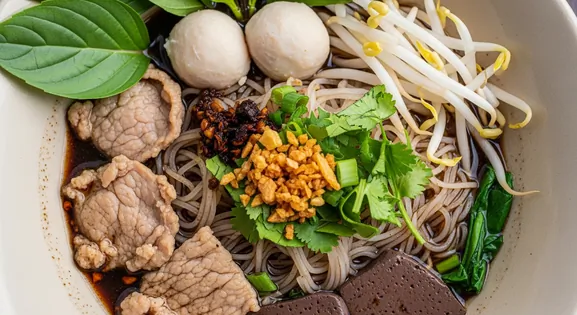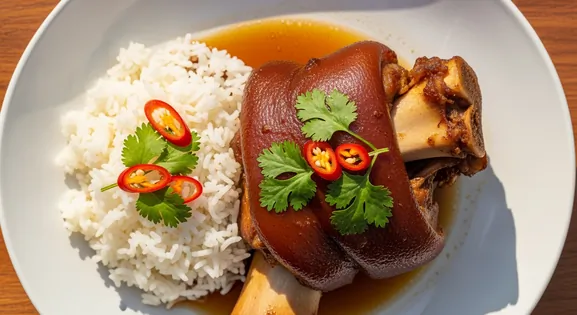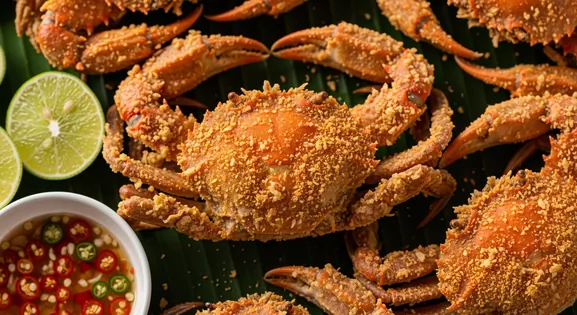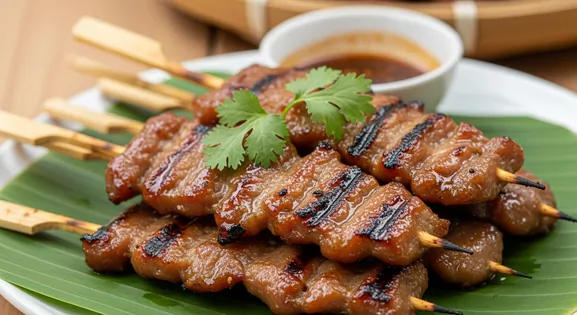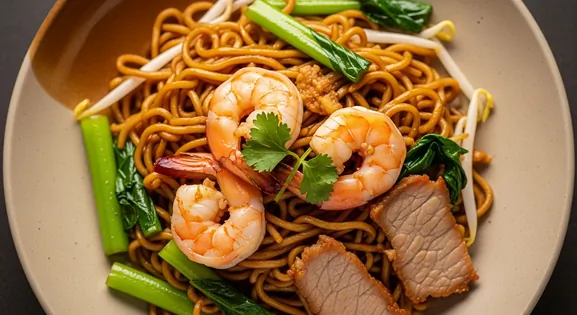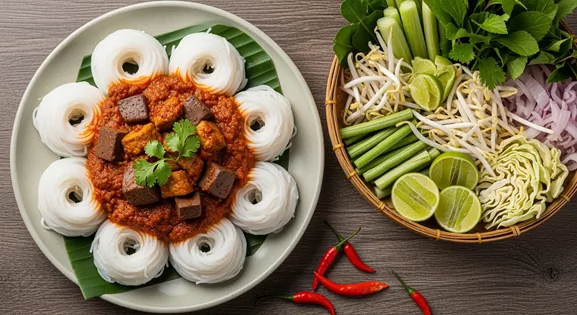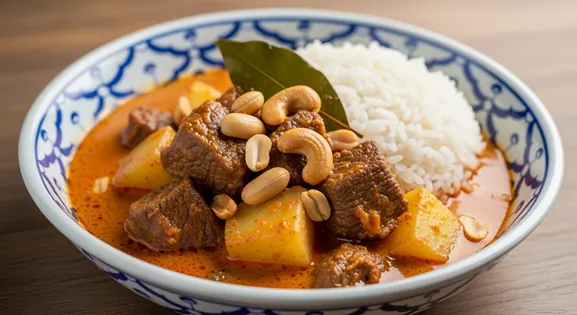Mango Sticky Rice in Thailand: A Complete Food Lover's Guide
ข้าวเหนียวมะม่วง (Khao Niao Mamuang)
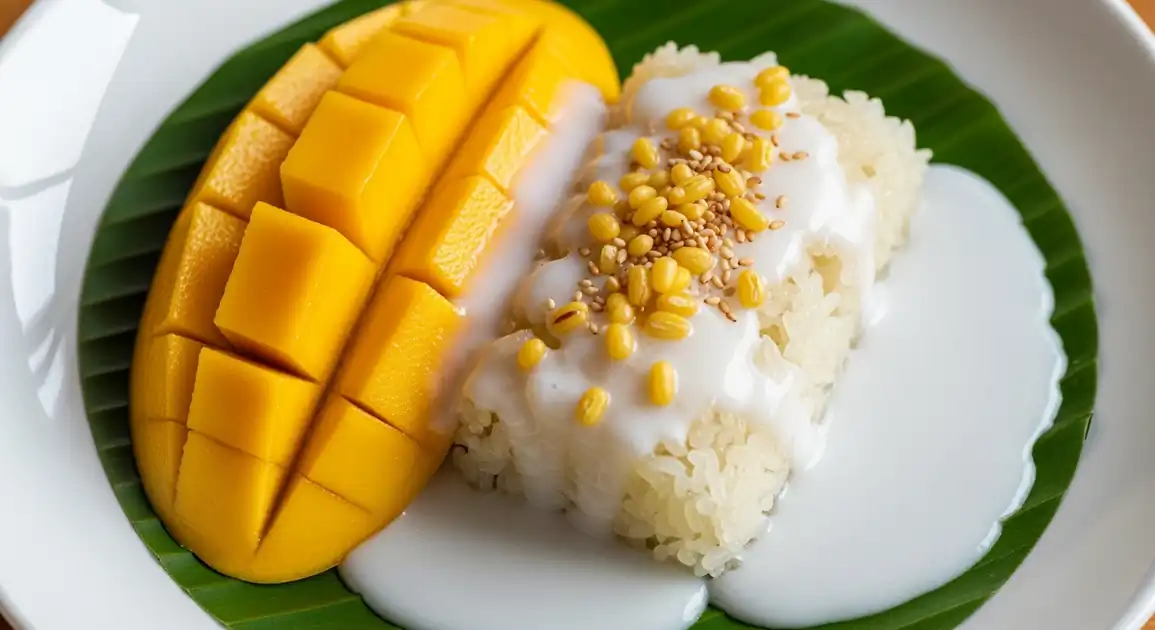
Understanding This Dish: An Introduction
Khao Niao Mamuang, or Mango Sticky Rice, is Thailand's iconic dessert. It features sweet glutinous rice infused with rich coconut milk, paired with slices of luscious, ripe mango. Often topped with extra coconut cream and crispy toppings like sesame seeds, it offers a delightful combination of creamy, sweet, slightly salty, and fruity flavors with soft and juicy textures.
Universal Quality Indicators
What to Look For
-
Ripe, freshly cut mango
Mango should be vibrant yellow/gold, sweet-smelling, and cut upon order or look recently prepared. Avoid brown, mushy, or sour-smelling mango.
-
Fresh-looking sticky rice
Rice should be moist, glossy, and soft. Avoid rice that looks dry, hard, discolored, or has been sitting out uncovered for long periods.
-
Fresh coconut milk/cream
Coconut milk spoils quickly in heat. Look for white, creamy sauce. Avoid anything yellowish, separated, bubbly, or smelling sour, which indicates spoilage.
-
Vendor assembles the dish to order
Ensures maximum freshness, especially for the mango and coconut cream topping. Pre-assembled boxes sitting in the sun are riskier.
-
Clean preparation area and utensils
Look for clean cutting boards, knives, spoons, and containers. Observe hygienic handling practices.
What to avoid
-
Mangoes that look bruised, overly soft, or brownish
These are signs of overripeness or spoilage.
-
Coconut cream that smells sour or looks separated/yellow
Spoiled coconut milk can indicate poor handling. Trust your nose and visual cues.
-
Pre-packaged portions left sitting in direct sunlight or heat
Heat accelerates spoilage, especially of the coconut milk and mango.
-
Sticky rice that appears dry, hard, or discolored
Indicates it's not fresh or properly prepared.
-
Visible flies or pests around the food display
A clear sign of poor hygiene.
How to Order Mango Sticky Rice
What to Serve with This Dish
Thai Iced Tea (Cha Yen)
Beverage
The creamy, sweet, and aromatic Thai iced tea offers a refreshing contrast to the richness of Mango Sticky Rice, cleansing the palate between bites.
Fresh Coconut Water
Beverage
A natural and hydrating choice, fresh coconut water provides a light, subtly sweet accompaniment that complements the tropical flavors of the dessert without overpowering it.
Explore Mango Sticky Rice in Detail: City Guides
Discover where to find the best Mango Sticky Rice and learn local tips in these cities:
The Culinary Legend of Mango Sticky Rice
Mango Sticky Rice is a traditional Thai dessert with roots possibly dating back to the late Ayutthaya period or early Rattanakosin period. It showcases key Thai ingredients: rice, coconut, and seasonal fruit. It gained immense popularity both domestically and internationally, becoming synonymous with Thai cuisine, especially enjoyed during the hot summer mango season.
Traditional Preparation Techniques
Glutinous rice is first soaked, then steamed until cooked. Separately, coconut milk is heated with sugar and a pinch of salt. The hot steamed rice is mixed thoroughly with this sweetened coconut milk ('moon') and allowed to rest, absorbing the liquid. Ripe mangoes are peeled and sliced. The dish is assembled by placing a portion of the sticky rice alongside mango slices, then drizzled with reserved coconut cream and sprinkled with toasted sesame seeds or crispy mung beans just before serving. Freshness of mango and coconut milk is key.
Key Ingredients of Mango Sticky Rice
Ripe Mango (Mamuang)
The star of the dish, typically 'Nam Dok Mai' or 'Ok Rong' varieties, known for their sweet, fragrant, and non-fibrous flesh. It should be perfectly ripe, yielding to gentle pressure.
Quality indicator: Look for vibrant yellow or golden skin, a sweet aroma, and a firm but slightly soft texture. Avoid any with bruises or dark spots.
Glutinous Rice (Khao Niao)
Also known as sticky rice, this special variety becomes translucent and sticky when cooked. It's steamed and then "moon" (mixed) with sweetened coconut milk, absorbing its rich flavor.
Quality indicator: The rice should be soft, chewy, and distinct, not mushy or hard. It should have a glossy sheen from the coconut milk.
Coconut Milk (Kati)
Used in two forms: a sweetened mixture for the rice and a richer, slightly salty cream for drizzling. It provides the dish's signature richness and balances the mango's sweetness.
Quality indicator: The coconut milk should be fresh, white, and creamy. Avoid any that appears separated, yellowish, or has a sour smell.
Local Mango Sticky Rice Variations in Thailand
With Crispy Yellow Mung Beans
Toasted or fried split mung beans are sprinkled on top instead of, or in addition to, sesame seeds, adding a crunchy texture.
Different Mango Varieties
While Nam Dok Mai and Ok Rong are classics, other sweet mango varieties might be used depending on availability and season.
Butterfly Pea Sticky Rice
Sticky rice naturally colored blue/purple using butterfly pea flowers, offering a visual variation without significant flavor change.
Black Sticky Rice
Sometimes made with black glutinous rice, which has a nuttier flavor and firmer texture.
Dietary Information
Dietary Information
Important Note for Travelers: Your safety is our priority. Below are the common allergens associated with the traditional preparation of this dish. However, recipes and ingredients can vary significantly between establishments. Always confirm all ingredients directly with the food vendor before ordering, especially if you have a severe allergy.
Potential Allergens
Dietary Suitability
Frequently Asked Questions about Mango Sticky Rice
What is Mango Sticky Rice?
Mango Sticky Rice (Khao Niao Mamuang) is a classic Thai dessert made from glutinous sticky rice steamed and mixed with sweetened coconut milk, served with slices of fresh ripe mango, and often topped with a drizzle of coconut cream and toasted sesame seeds or crispy yellow mung beans.
How to choose the best Mango Sticky Rice?
Look for vendors using ripe, fragrant mangoes (like Nam Dok Mai or Ok Rong during season) that are sweet and not fibrous. The sticky rice should be soft, slightly chewy, and well-infused with coconut milk, but not mushy. The coconut cream topping should be fresh and complement the sweetness. Busy stalls and specialty shops often indicate good quality.
Is Mango Sticky Rice a good choice from street vendors?
Generally yes, it's a popular and often well-prepared street dessert. Prioritize vendors who assemble it fresh per order. Key is the freshness of the mango (should look bright, not bruised or mushy) and the coconut milk (should look white and fresh, not separated or yellowish). Choose busy stalls with high turnover and clean preparation areas.
When is the best season for Mango Sticky Rice?
The peak mango season in Thailand is typically from late March to June. This is when you'll find the best quality, sweetest, and most affordable mangoes (especially Nam Dok Mai and Ok Rong varieties). While available year-round using different mango types or imported ones, it's exceptionally good during the peak season.
Is Mango Sticky Rice vegan/vegetarian/gluten-free?
Yes, traditional Mango Sticky Rice is vegetarian, vegan, and gluten-free. It consists of rice, mango, coconut milk, sugar, and sometimes salt and sesame seeds/mung beans. Always confirm with the vendor if you have severe allergies, as cross-contamination is possible, and very rarely, non-traditional recipes might add dairy (condensed milk), though this is uncommon.
What kind of mango is typically used?
The most prized mango varieties for Mango Sticky Rice in Thailand are 'Nam Dok Mai' (golden yellow, sweet, fragrant, less fibrous) and 'Ok Rong' (paler yellow/greenish, distinct aroma, slightly more tart-sweet). Other varieties may be used depending on the season and region.
Expert How-To Guides about Mango Sticky Rice
How to Spot Fresh Mango Sticky Rice
Identify vendors selling high-quality, fresh, and delicious Mango Sticky Rice, ensuring a delightful experience.
- Observe the Mangoes: Look for bright, unbruised, ripe mangoes being peeled and sliced freshly. Avoid vendors using pre-sliced mangoes that look dry or browned.
- Check the Rice: The sticky rice should look moist, plump, and pearly white (or naturally colored), not dry, hard, or mushy.
- Assess the Coconut Cream: The topping sauce should look fresh, white, and creamy. Avoid sauces that appear yellowish, separated, or smell sour.
- Look for Fresh Assembly: Ideally, the vendor assembles the dish upon order, adding the mango and sauce just before serving.
- Evaluate Stall Cleanliness: Choose vendors with clean cutting boards, knives, serving utensils, and overall tidy stalls.
- Note the Toppings: Sesame seeds or mung beans should look freshly toasted and crisp, not stale or oily.
Understanding Mango Sticky Rice Components
Know the key parts of the dish to better appreciate its flavors and quality.
- The Mango: The star ingredient. Quality depends on ripeness, sweetness, and variety (Nam Dok Mai is popular).
- The Sticky Rice (Khao Niao Moon): Glutinous rice steamed then mixed with sweetened coconut milk and left to absorb ('moon'). Should be soft yet hold its shape.
- The Coconut Cream Topping (Nam Kati): A richer, often slightly salty coconut cream drizzled over the rice and mango to balance sweetness.
- The Garnish: Toasted white sesame seeds ('Nga Khao Khua') or crispy fried yellow mung beans ('Thua Thong Thot') add texture and nutty flavor.
Our Commitment to Quality
At Tasteplorers, our mission is to provide the most accurate and useful travel information in the world. To achieve this, all content on this site is created through our unique editorial framework. We utilize leading AI research tools, guided by our proprietary prompts, and a multi-stage validation process. This entire system is overseen by our editorial team to ensure everything we publish meets our high standards for accuracy, cultural nuance, and practical value for travelers.
Learn more about our Editorial Process and our Mission.
Countries
Explore regions
Europe
Discover Europe's diverse culinary landscape, from Mediterranean flavors to hearty Alpine fare. Learn to navigate markets, decode menus, and eat like a local.
Latin America & Caribbean
Discover the vibrant cuisines of Latin America & the Caribbean. Our expert guide covers everything from Mexican street food to Peruvian ceviche and market tips.
Oceania
Explore Oceania's diverse food scene. Learn about Polynesian earth ovens, Fijian feasts, and the vibrant café culture of Australia and New Zealand.
Southeast Asia
Explore Southeast Asia's diverse food cultures from Thailand to Vietnam. Get expert tips on navigating spice levels, choosing quality vendors, and understanding the rich traditions of the region.
